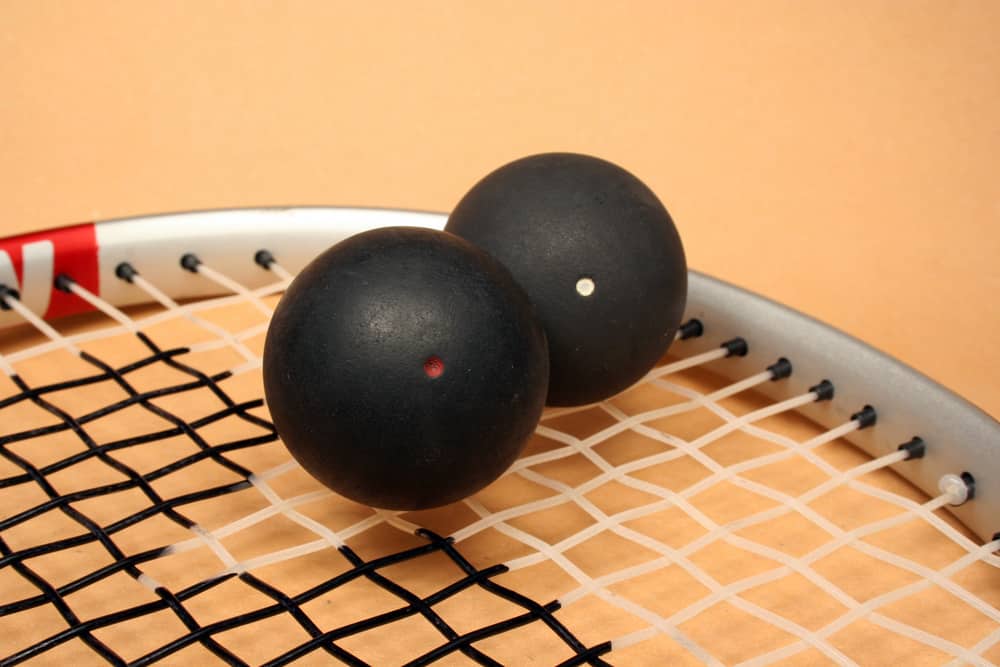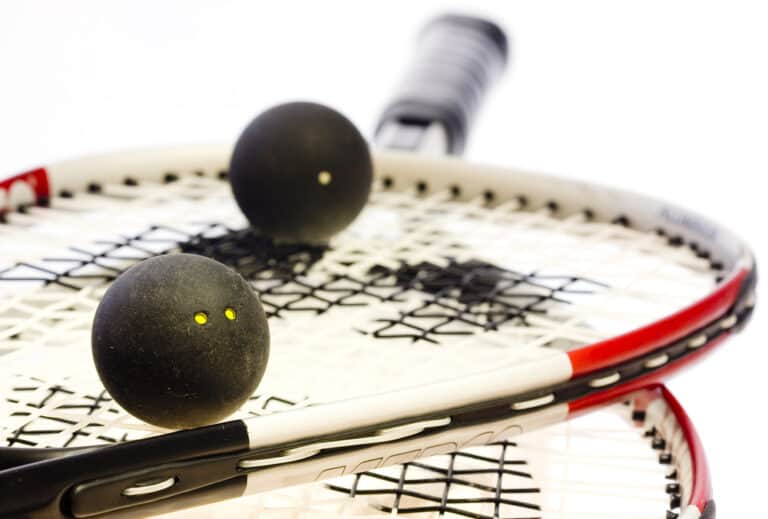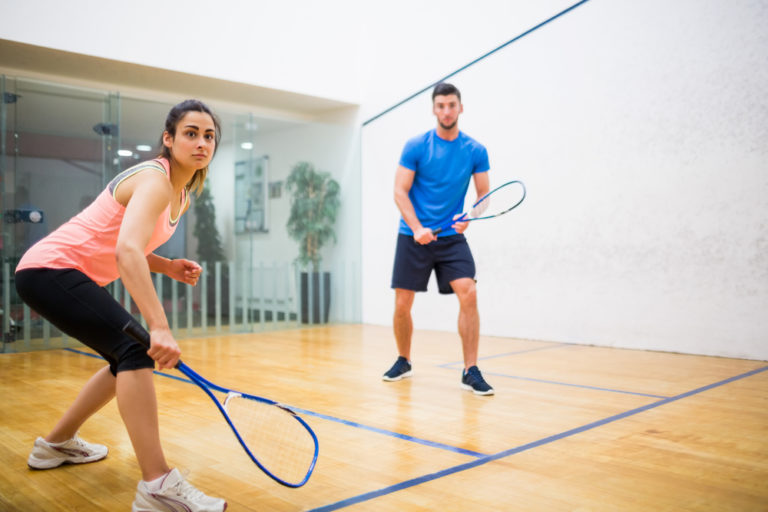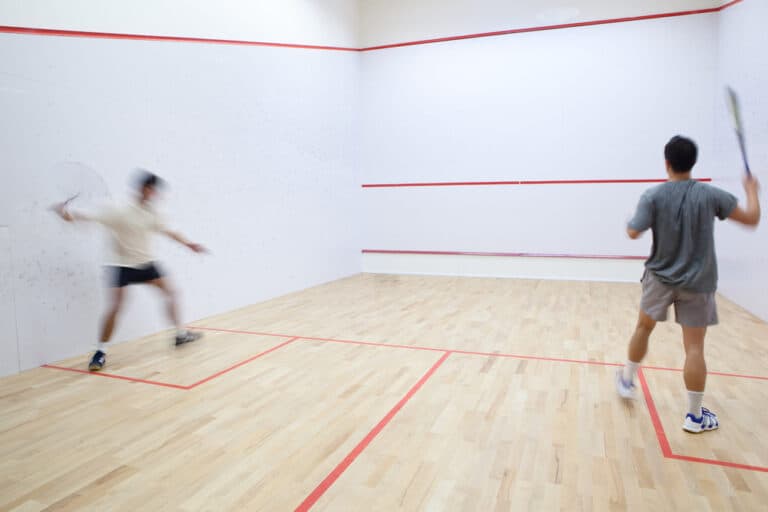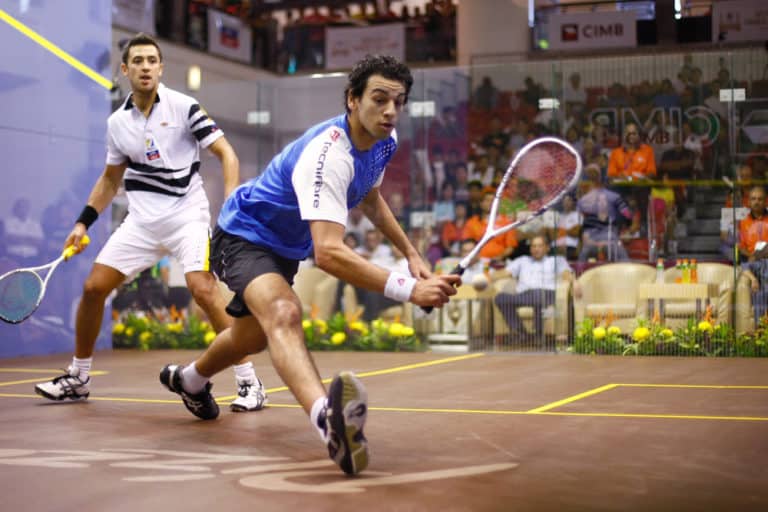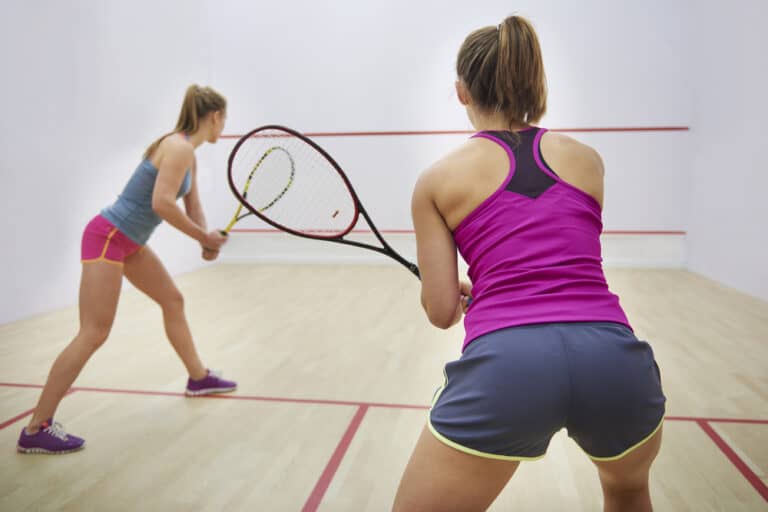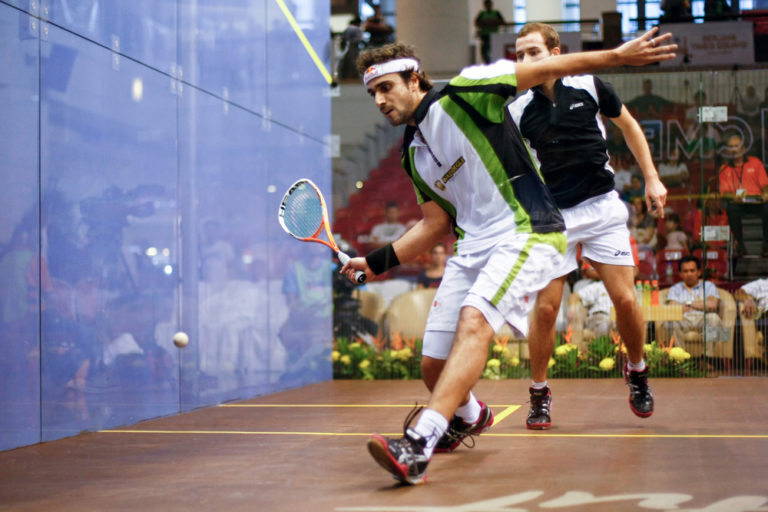What’s The Difference In Squash Balls?
Unlike other racquet sports, squash uses different balls depending on the level of bounce and speed required by the players. To make the game easier for beginners and more challenging for professionals, squash balls come in different options, denoted by the color of the dot on the ball.
The color of the dot on the ball determines the difference in squash balls; this color indicates how fast the ball is and how high it will bounce. Professionals and advanced players use lower and slower balls, while faster and bouncier balls are for intermediate, novice, and beginners.
The colors range from single dot blue and red for beginners and novices to white, green, and yellow, and double dot yellow, the ball designated for the professional player. So, let’s get kitted out and explore the different colors and dots on squash balls.
What Are Squash Balls Made Of
Before we look at the different types of squash balls, we need to learn a little more about how they are made and how temperature affects their performance.
Squash balls are made from raw butyl rubber, and believe it or not, it has the same hardness as a car tire! The elastic properties of butyl rubber allow it to deform when struck and return to shape very quickly.
This material is also used as it has high resilience and this, combined with the elasticity, gives the squash ball its fantastic ability to recover its natural rounded shape during the game.
Why Do You Need To Warm Up The Squash Ball Before Playing
This is another excellent property about squash balls.
As the rubber absorbs impact, this energy is converted to heat, and the air inside the center of the ball begins to warm up.
As the air gets hotter, it affects the ability of the ball to bounce and achieve the level of bounce indicated by the color of the dot on the ball.
The color determines how high the ball will bounce when it’s warmed up, and the ball’s hang time or speed during play.
It will take a few minutes for this to happen, and in that time, players can also warm themselves up and get ready for the game.
The warmer the ball gets, the higher it will bounce, and this is why the game of squash doesn’t stop for very long, as the ball will lose temperature and would have to be warmed up again before play could continue.
Remember that the lower the ball bounces, the more complex the game becomes, which is why the pros use very slow and low bouncing balls as this is a test of their skill and fitness, while beginners would use much higher bouncing balls as this allows them to have a decent game.
Why Does Squash Have Different Balls
Squash is a complex game with many different rules, strategies, and shots available to players. But the most influential aspect of the game is the ball.
Squash is played on a court with a wooden floor and four walls, and the ball is only allowed to bounce once off the floor during play.
If it bounces more than once, the point is awarded to the player who last hit the ball.
As with all sports, there are players that have different skill levels from beginner to professional. While fitness, good technique, and understanding of the game and its strategies are critical to being a good squash player, using the right ball is equally important.
For beginners, a very slow ball bouncing too low would be frustrating and wouldn’t allow them to develop technique, fitness, and confidence.
For advanced and professional players, a ball with too much bounce and hangs time would be as frustrating as it would be too easy to play and make winning points difficult as the precision ‘ killer shots would bounce too high and make them easier to get to and return.
So each squash ball has a different level of bounce and speed, and the lower and slower balls are also smaller than the faster balls.
This makes them that much more challenging to hit in the sweet spot of the racquet and requires greater precision and skills to play at that level.
Now that you understand more about why squash has different balls, let’s look at each in more detail.
How Are Squash Balls Rated
Squash balls are rated by speed and color; each color denotes a different level of bounce and pace.
Balls are ranked from fast to ultra-slow, with the slowest balls used by advanced and professional players and the fastest ones used by beginners and novices.
Single Dot Vs. Double Dot Squash Balls
Single dot balls are the most common, and unless you are a pro player, you would be using single dot balls in color best suited for your game.
Double dot balls only come in yellow and are the standard squash ball used in professional competition.
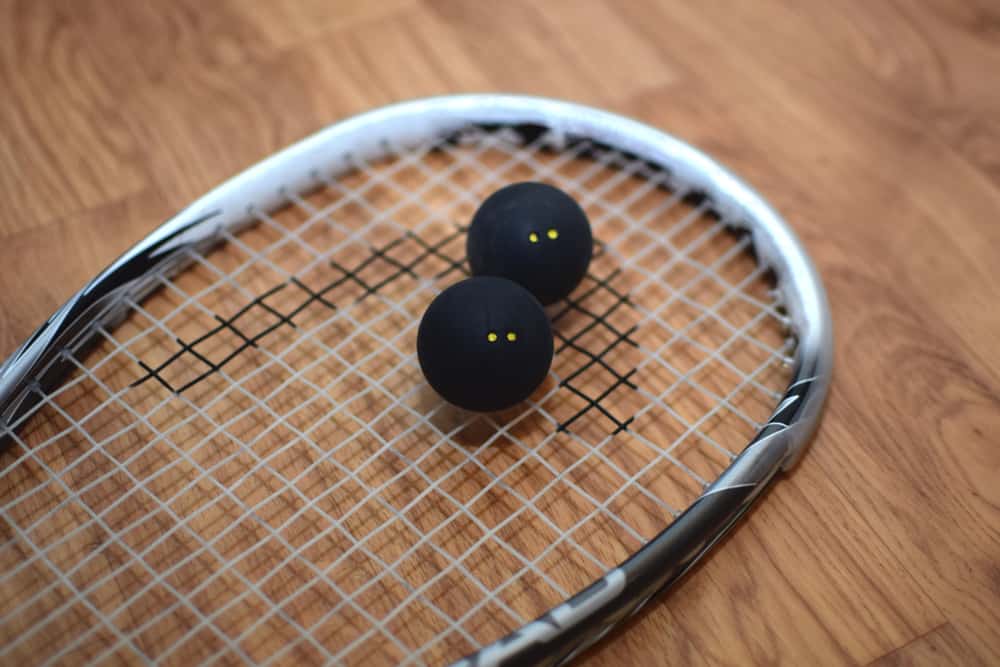
What Color Squash Balls Do You Get
Squash balls come in seven primary colors blue, red, yellow single dot, and yellow double dot.
You also get squash balls with white, green and orange dots; while these are not uncommon, they are less so than the standard four colors.
Let’s look at the four primary colors of squash balls and what they mean, and then we can check out the three less standard colors.’
When considering the size and bounce of the ball, we will use the double-dot professional ball as the comparative ball
Single-Dot Blue Squash Ball: Fast
This ball is the largest of the four and has the highest bounce and speed. It is larger than the double-dot yellow ball by 12% and has 40% more bounce. This ball is the easiest to hit, and because it is bigger and bouncier, it is the ideal ball for beginners.
The single dot blue ball doesn’t need as much warm-up time as other squash balls, so beginners coaching lessons or playing a game don’t have to wait long before they can start their match.
Another reason that the single blue dot ball is ideal for novice players is that you don’t need to hit it as hard as the double-dot yellow to warm it up and hit good shots, so it is a great way to learn the techniques and develop your fitness.
As a beginner, having to hit the ball with full power always would be very tiring and risks injury due to a lack of conditioning and strength.
It also wouldn’t allow you to develop good shot techniques for both power shots and drop shots, so the single dot blue ball requires less power and precision to hit, and it gives you more time to hit the ball due to the higher bounce.
Single-Dot Red Squash Ball: Medium
This is the intermediate ball and is used by players with some skills but still developing fitness and technique.
It is 6% larger and has 20% more bounce than the double-dot yellow ball. Considering that the single dot blue ball has double this bounce and size , you can understand that using the single dot red ball is a fairly big step up in the game’s skill and fitness levels.
Compared to the single-dot blue ball, the red ball is twice as challenging to play as the blue.
It is smaller and slower, and this ball can produce fast and fun games, but it can also be used in a more competitive aspect between players of this level.
For coaches looking to improve and develop the fundamentals of the game, the single-dot red ball is a favorite, as while it does not have the difficulty of the single-dot yellow and double-dot balls, it is much more challenging than the single-dot blue ball.
Single-Dot Yellow Squash Ball: Slow
Until 2001, the single-dot yellow ball was the choice for advanced and professional squash players.
Compared to the double-dot yellow ball, this one has 10% more bounce, but it is the same size as the professional ball. Squash players at this level are fitter, faster, and have better-shot techniques to play the slower and lower ball.
One of the considerations when using this ball in competition is the climate, and this is also where we see the other non-standard color balls come into play.
Even though this ball has a higher hang time and more bounce, this could be offset by colder air or lower air pressure.
Because the air temperature and pressure play a role in the squash balls’ performance on the court, where there is colder air moving through the court vents, or the game is played in colder climates, the ball will lose temperature faster and start to play almost like a double-dot ultra slow ball.
This is why the double-dot yellow could be super-slow in some colder climates, and the single-dot yellow would be preferable for professionals.
Double-Dot Yellow Squash Ball: Ultra-Slow
Since 2001, this has been the default ball choice for professional and advanced players alike. Beginners may often think that this is the ball they should use as they see it on TV, but as mentioned before, beginners using this ball would become demotivated and despondent as they would not be able to play a good game with it.
This ball has very low hang time and bounce, so to use this ball means you need to be very fit, have excellent racquet technique, and have a good understanding of on-court strategy. This ball should not be used by players other than pros or those at a very advanced level.
The Single-Dot Green Pro Squash Ball: High Altitude Ball
The single-dot green pro squash ball bounces even less than the double-dot yellow ball. Still, this ball is only for use at high altitudes only with lower air pressure, and the Professional Squash Association would determine this before the allocation and approval of this ball for use in pro events.
This ball was designed to compensate for lower air pressure that would make the double-yellow dot ball bounce higher, becoming more like the single-dot yellow ball in character.
Single-Dot Green Ball – Average Bounce And Speed
You also get a single-dot green ball that has a medium bounce and can be used by average players but is not designated as a professional ball so check the box for the ball’s designation before buying it.
The Single-Dot Orange Squash Ball: For High Altitude
Another ball designed for high-altitude and warmer temperatures are the single-dot orange ball, often used in places like Mexico City, Johannesburg in South Africa, and Calgary. In contrast, the single-dot green ball is used in North America.
These balls are often designated as ‘ultra-slow,’ but they are used only where the atmospheric conditions demand it.
The Head Single-Dot White Squash Ball: For Children And Beginners
This ball is similar to the blue single-dot ball as it has the same bounce rating at 40% higher than the double-yellow dot. Dunlop produces the blue dot ball, while Head produces the white dot ball with the same characteristics.
It doesn’t need warming up and can be used immediately to get the game going.
You should also know that some white dot balls are rated low-bounces for intermediate players, which can be confusing when looking for the right ball to use.
Different Brands Have Different Bounces For The Same Color
While the standard ball colors of blue, red, single yellow and double yellow are standard, there are some makes of squash balls that designate the same colors (like white) for different levels of skill, so never assume that a white Head squash ball designated for beginners has the same characteristics as the FJ white dot ball which is for intermediate players.
Always check the ball rating before buying it to ensure that you purchase a squash ball suited for your level of play.
Conclusion
Now that you know and understand the differences between the squash balls and what the various colors mean in bounce hang time, and speed, you can easily select the right ball for your level of skill in the game.
Playing squash and getting the most out of your game, whether you are a pro or a beginner, will significantly depend on the ball you use, but now, choosing the right one has never been easier- so go ahead, pick your ball and get into your next game!

